This is a guide that will give you all the tools needed to negotiate.
How do you know you are in a negotiation?
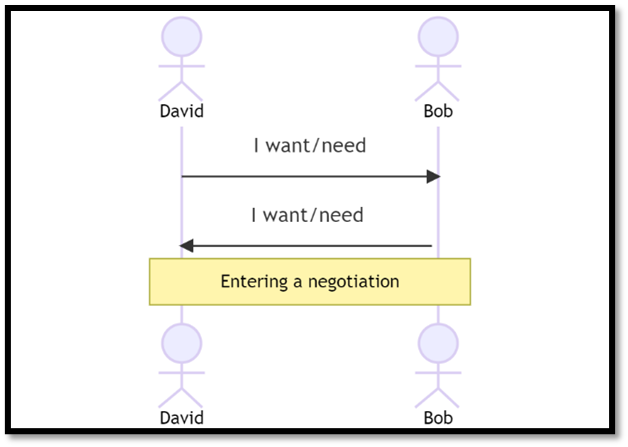
-
If the words “I want” or “I need” are about to come out of your mouth, you are about to enter into a negotiation
-
Anytime one person wants something from another person, you are about to enter into a negotiation
Goal
Negotiation begins with the universally applicable premise that people want to be understood and accepted. Listening is the cheapest, yet most effective concession we can make to get there. By listening intensely, you demonstrate empathy and show a sincere desire to better understand what the other side is experiencing.

- People want to be understood and accepted. 2 primal urges:
- Need to feel safe & secure
- Need to feel in control

- Listen intensely → demonstrate empathy + show a sincere desire to better understand what the other side is experiencing
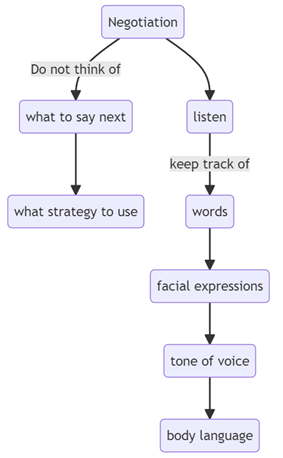
- When you are in a negotiation, just concentrate on listening to the other person. Do not think about what you are going to say next, what strategies you will use next, etc. It takes a lot of work to keep track of what the other person is saying, tracking their facial expressions, their tone of voice, their body language. Negotiation is the art of discovery.
Tone
How you speak matters, below are some helpful tips to consider.
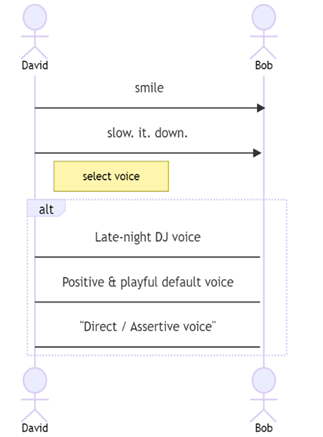
- Smile
- Slow. It. Down
- Three voices:
- Late-night DJ voice: Use selectively to make a point. Inflect voice downward. Calm and slow. Creates aura of trustworthiness without triggering defensiveness
- Positive & playful: Default voice. Voice of easygoing & good natured person. Relax & smile while talking
- Direct / Assertive: Used rarely, I do not recommend to use. You are signaling dominance. Your counterpart will either aggressively or passive-aggressively push back against attempts to be controlled.
Preparation
Contrary to popular belief, it’s possible to learn almost everything you need to know about your potential client in the negotiation itself. Before entering a negotiation, you need to
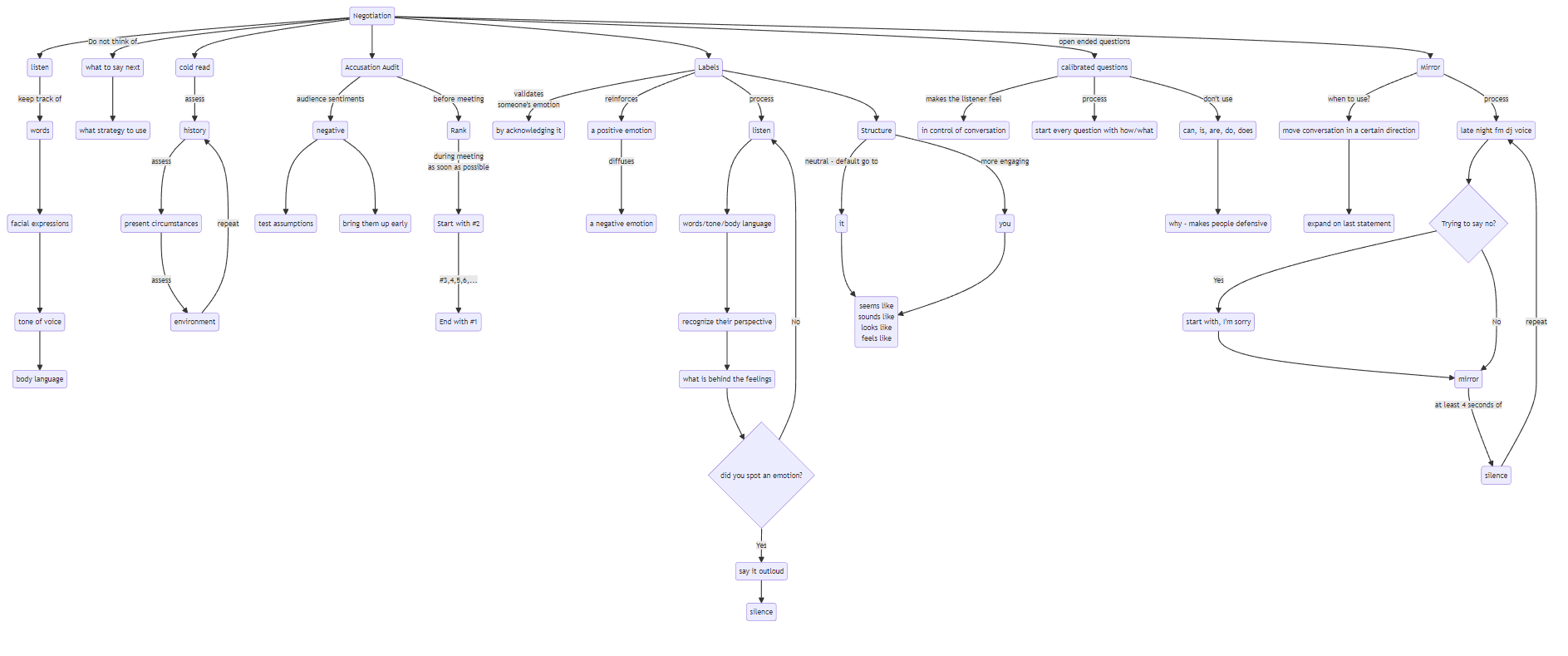

Cold Read - The process of assessing your environment, the present circumstances, and any history that might impact how your audience receives your message before you attempt to get a yes
- A negotiation is a fluid situation, so you will be re-assessing your environment throughout the entire process.

Accusation Audit – Write down all of the predictable positive and negative sentiments your audience is likely harboring. This includes the worst things the potential clients can say about you or your firm.
- These are all assumptions that you will test in the negotiation.
- Rather than denying that these hurdles exist, it’s in your best interest to embrace them and address them early on in the negotiation.
- Saying them early and first will take the sting out of the bad things that someone can say about you.
- Rank the negative sentiments from the worse down to the not so bad.
- Start the AA with #2
- End with #1
- The last impression is the lasting impression. You want to end by letting them know you understand what their biggest issue/hurdle/sentiment is
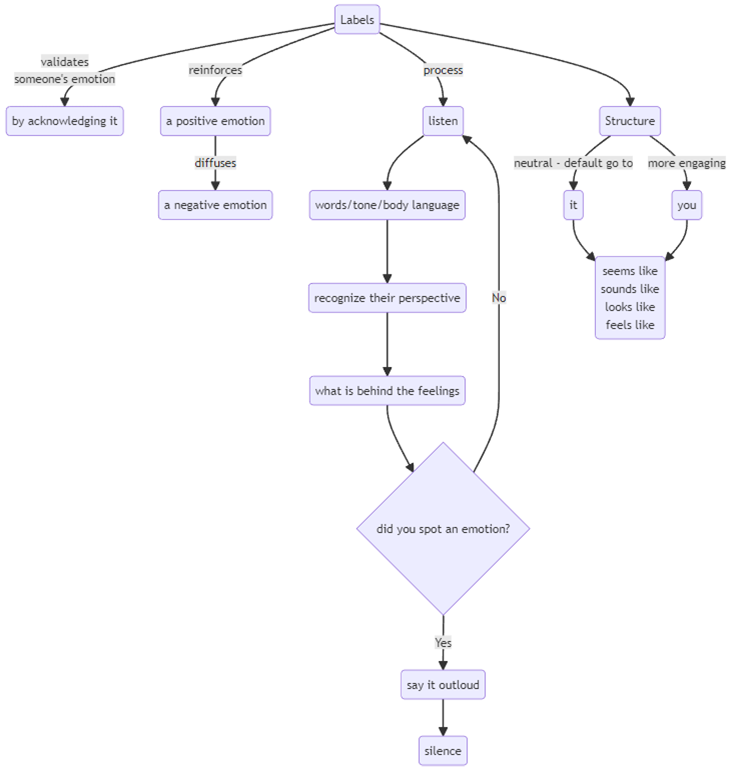
3-5 Labels to perform an Accusation Audit - Labeling is a way of validating someone’s emotion by acknowledging it. Give someone’s emotion a name and show you identify with how that person feels.
- Labels help
- Booster/reinforces a positive emotion
- Diminish/diffuses a negative emotion
- Labeling process
- Imagine myself in the counterpart’s situation
- Recognize their perspective
- Understand counterpart’s feelings & hear what is behind those feelings
- Bring my attention to the emotional obstacles to getting an agreement done
- Look at words, tone, and body language. Spot changes and look for incongruencies
- Once you think you think you spotted an emotion, the next step is to say it aloud.
- If they disagree, say “I didn’t say that is how it was, I just said it seems like that”
- The last step is silence.
- Structure
- Start with
- It – neutral (default go to)
- You – more engaging (can be delivered incorrectly, and sound like you are accusing the other person)
- seems like… sounds like… looks like… feels like
- Start with
- Examples
- It seems like ____ is valuable to you
- It seems like you don’t like ____
- It seems like you value ____
- It seems like ____ makes it easier
- It seems like you’re reluctant to ____
- It sounds like ____
- It looks like ____
- You seem like ____
- Your goal is to label the emotion that is fueling the persons behavior
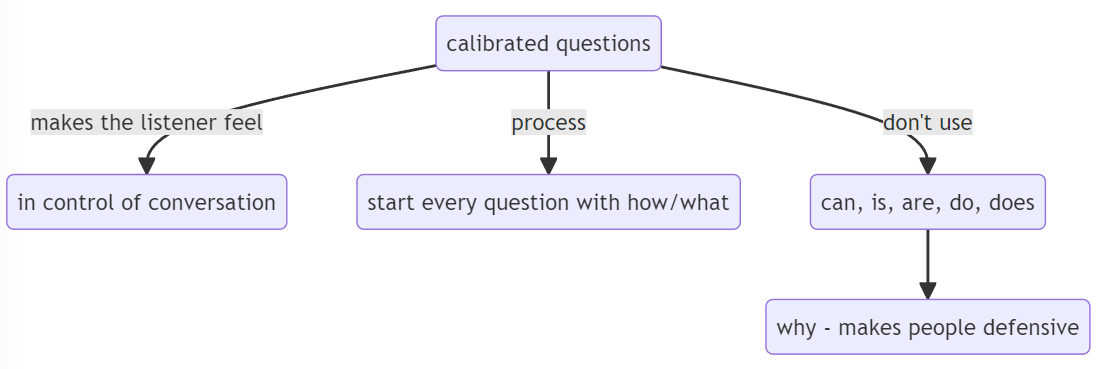
-
3-5 Calibrated Questions** – Open ended questions designed to keep your client talking and open up to you.
-
Start every question with what or how
-
For your potential client:
- What are we trying to accomplish?
- How is that worthwhile?
- What’s the core issue here?
- How does that affect things?
- How does this fit into what the objective is?
-
To identify behind-the-table deal killers:
- How does this affect the rest of your team?
- How on board are the people not on this call?
- What do your colleagues see as their main challenges in this area?
-
To identify and diffuse deal-killing issues:
- What are we up against here?
- What is the biggest challenge you face?
- How does making a deal with us affect things?
- What happens if you do nothing?
- What does doing nothing cost you?
- How does making this deal resonate with
- What your company prides itself on?